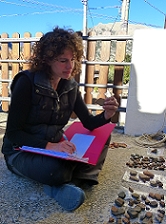Rural life in Protohistoric Italy: Relating subsurface remains to archaeological survey data

Drs. Wieke de Neef
E-mail: w.de.neef@rug.nl
Promotor: Prof. dr. P.A. J. Attema
Co-promotor: Dr. P.M. van Leusen
Period of employment: 2010-2015
Financed by: NWO
Project description:
This research project focuses on the interpretation of ephemeral surface scatters from the protohistoric period (Bronze and Iron ages, ca. 2000-1000 BC), mapped during previous GIA survey projects in Calabria, Italy. As such sites often consist only of a few poorly datable pottery fragments, it is difficult to assess their function within land use systems and their place in regional settlement patterns.
In order to build an interpretation model, I investigate if, and if so, which buried remains can be related to surface sites, and why they are preserved. This model is based on a site typology based on topographical and material characteristics of the 160 protohistoric scatters which have been mapped in the Raganello watershed.
The field investigations involve detailed archaeological survey, non-invasive geophysical prospection techniques and invasive approaches for site detection and assessment (coring, test trenches) on representative examples of different site types. Aim is the development of an interpretation model for small protohistoric find spots which can be used in other areas in Italy / the Mediterranean, and the development of a quick, non-invasive method to detect and describe the function, state of preservation, and archaeological importance of such sites. This may be used by local heritage managers, who are faced with the rapid disappearance of archaeological sites due to mechanical agriculture practices and soil erosion.
| Last modified: | 23 July 2018 1.29 p.m. |
